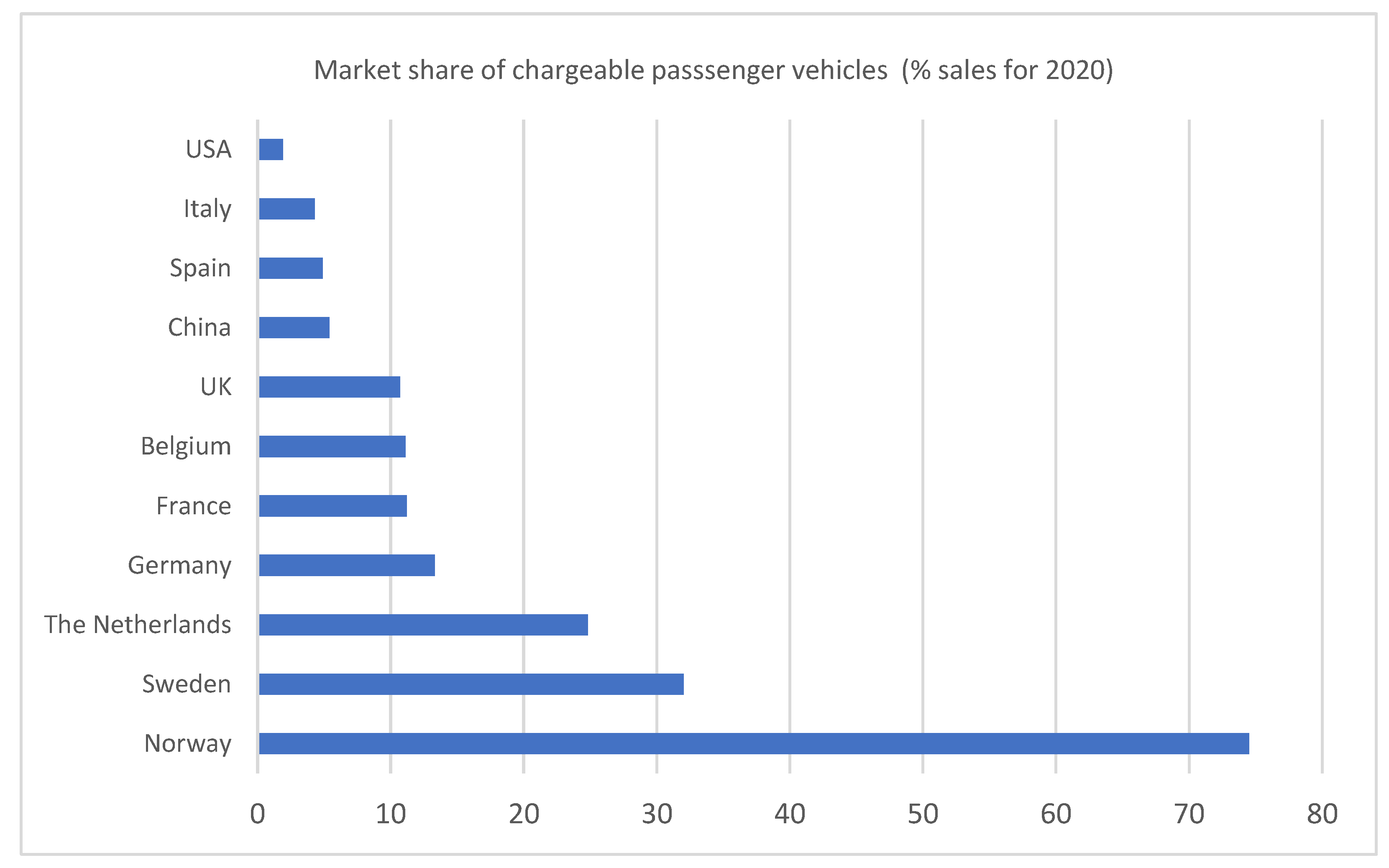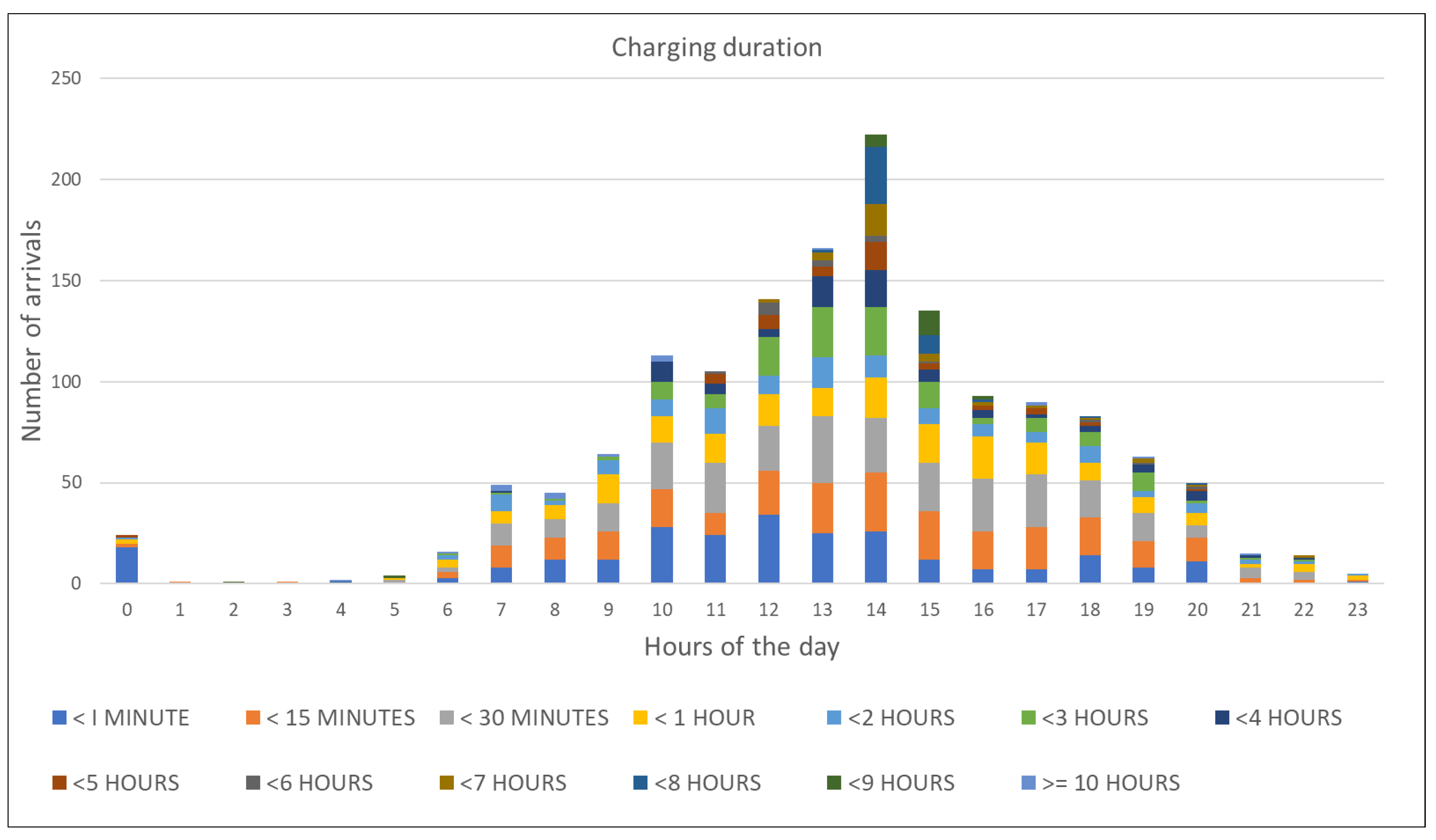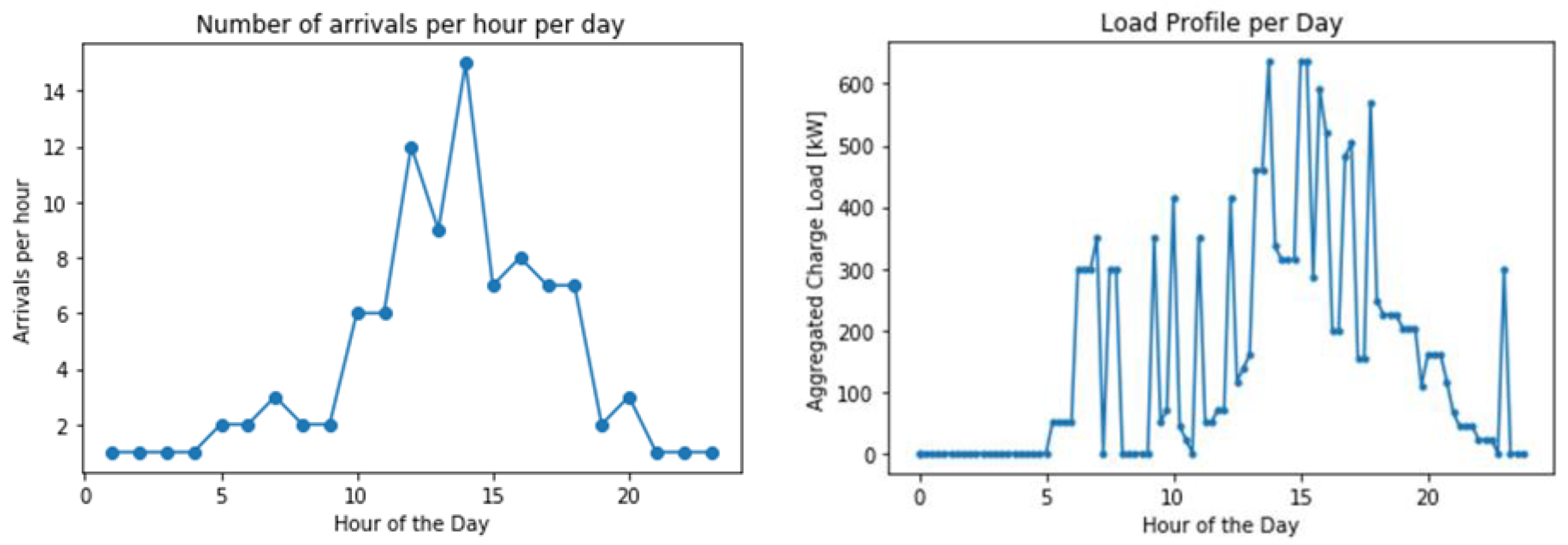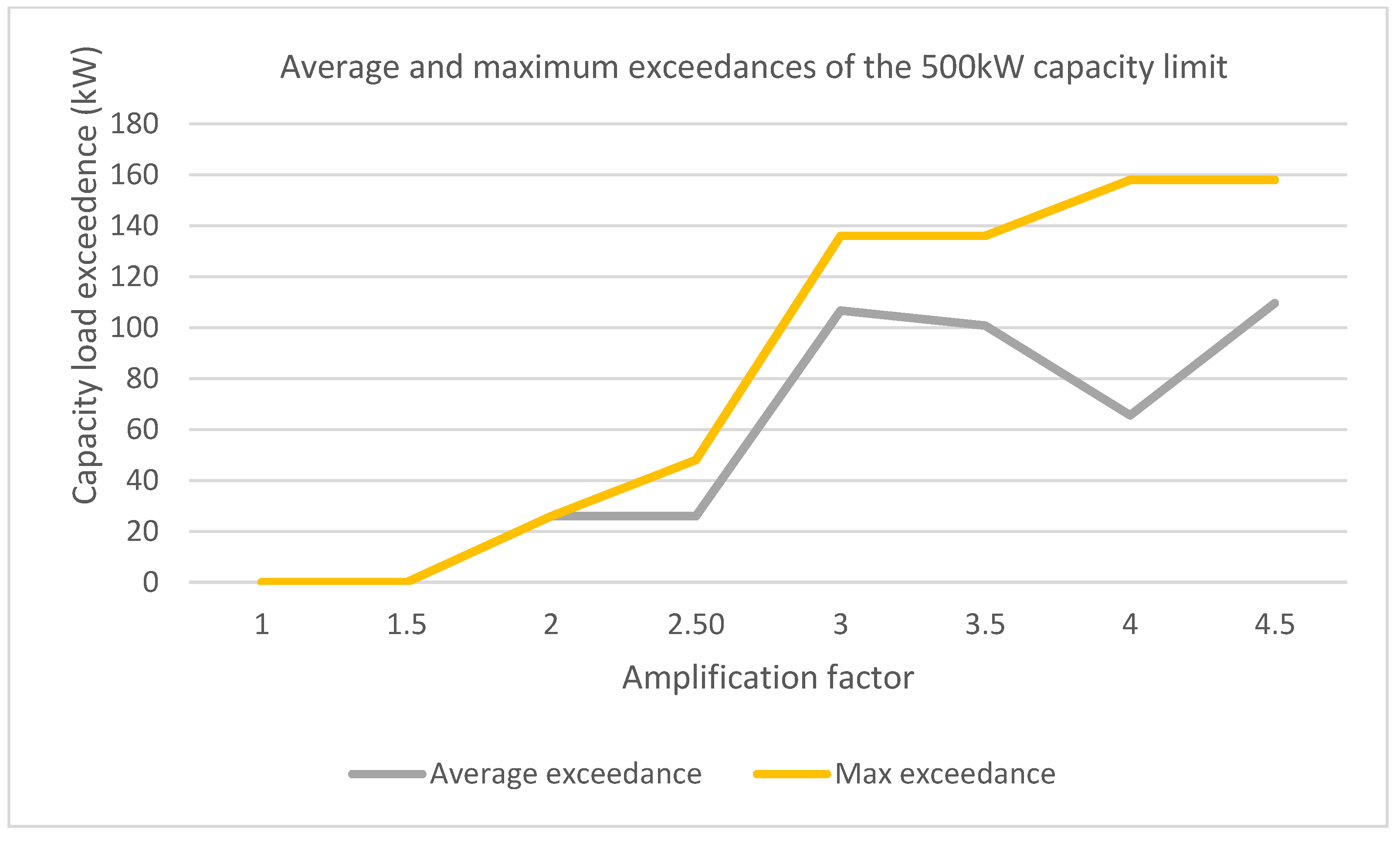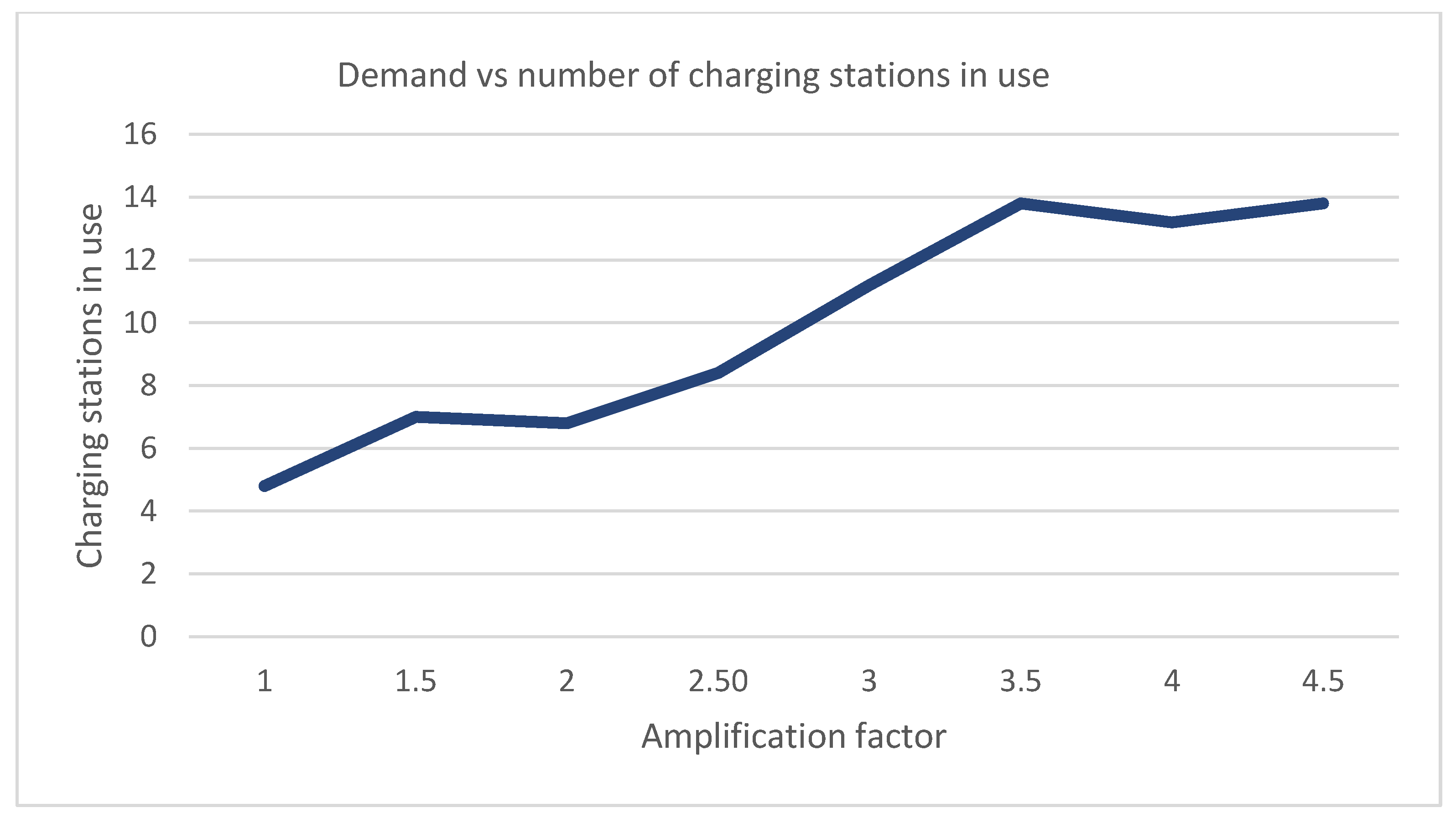1. Introduction
Electrification in transport is seen as one of the main means for reducing pollution and mitigating climate change. According to the European Commission [
1], transport represents almost a quarter of Europe’s greenhouse gas emissions and it is considered the main cause of poor air quality in cities. Transport electrification, combined with a high share of renewable generation in the power system, can significantly mitigate climate change. In particular, as shown in [
2], the increasing penetration of electric vehicles (EVs) can reduce the mitigation cost associated by the 2 °C climate stabilization target.
Having perceived the positivity of the personal driving experience and the contribution to climate targets, the number of people who express a preference for electric vehicles (EVs) is rapidly increasing. In Norway, e-mobility development has been intensive for several years and the country represents one of the most mature EV markets in the world. The market share of purely electric and chargeable hybrid vehicles in Norway accounts for almost 75% of the sales of new cars [
3], bringing the country to the world’s forefront when considering electric vehicles per capita (
Figure 1).
Furthermore, the sales indicate that EV ownership cuts through sociographic, geographic, and demographic boundaries, with a variety of people being represented among EV owners [
4,
5,
6]. These specificities of the Norwegian EV market offer a basis for carrying out unique studies in which a fair amount of empirical data can be utilized. However, the increasing numbers of EVs on the roads pose significant challenges to the power grid. The high capacity needs associated with fast charging or simultaneous charging of a number of vehicles and the unpredictability of the EV owners’ charging patterns can cause major operational problems for grid operators [
7]. Among the most often discussed challenges, as related to EV charging, are increased load in the distribution network, the difficulty of optimizing the operational processes in the grid, new requirements for distribution network planning and threatened power quality [
8]. Moreover, as pointed out in [
8], as the access volume of electric vehicles increases, the reliability of the power can be expected to decrease.
Yet, according to the authors of [
10], the variety of disadvantage effects associated with EV charging can be reduced by rebuilding and expanding the distribution network, through governance of technology and through proper optimization techniques. However, while expansion of grid infrastructure usually has a very high cost, the possibility of accommodating EV charging through smart-charging approaches and local system optimization constitutes a most attractive alternative which is worth investigating. Such an alternative is even more attractive when one considers that improved EV charging methods can help alleviate the grid burden associated with home charging and cut down on the waiting lines at popular charging locations.
The challenges and impacts associated with the increasing need for EV charging have been discussed from various perspectives in the literature, often based on scenarios and simulations. To mitigate the negative impact on the reliability of the electricity grid, the authors of [
11] proposed applying convex relaxation and proper rounding techniques, which can successfully handle the combinatorial optimization problem of EV charging. According to the authors of [
12], the challenges associated with uncontrolled EV charging can be referred to voltage profile, power loss, grid unbalance, reduction in transformers’ lifetime and harmonic distortion. Having performed an extensive review of the different EV charging strategies, the authors of [
12] classified them into scheduling, clustering and forecasting, and recommended additional research to address issues related to customer privacy and secure and reliable communication system cost management. In [
13], the impact of EVs on the development of the future power grid was discussed, with the importance and role of EVs in the future energy internet put in focus.
Although there is significant research interest towards the implications of EV charging, the studies based on real-life implementations are of limited scope. Some experiences from EV charging have been described in [
14], where it was pointed out that smart charging can contribute to avoiding higher cost periods of energy supply, increase customer engagement and help customers manage their EV use, defer or avoid investments in grid infrastructure, enable renewable energy integration and facilitate grid services. The large-scale pilot experiences described in [
15] showed that, by steering the power demand of EVs (known as smart charging), the grid limits can be successfully avoided and electricity cost can be kept lower. According to the authors of [
15], the benefits could include increased usage of renewable energy and avoiding costly capacity tariffs. It was further suggested in [
15] that smart charging is particularly beneficial during winter times. A recently undertaken smart charging initiative [
16] aimed to develop a large-scale smart charging solution that can be rolled out nationwide by flexibility service providers such as charging point operators (CPOs), aggregators and energy suppliers. At the core of the initiative lies the stakeholders’ ambition to have a smart charging solution that gives them both choice and freedom over the way their EVs are charged, at the same time as reducing charging costs [
16].
An overview of the business models associated with EV charging was provided in [
17], where the focus was placed on five categories: regional fast-charging networks, local (small) business initiatives, commercial EV charging, E-fleets and municipal and sustainable e-mobility. With a growing number of EVs on the European roads [
18], the need for business models that incorporate attractive EV-charging opportunities is increasing. Such models should offer a sound business case where risk is mitigated, profit from EV charging is ensured and operating costs are low [
17], whilst simultaneously taking into account EV drivers’ experience and remuneration. The current paper proposes a charging station configuration that can accommodate these requirements, embracing a variety of EV charging needs and suppliers and aiming to provide the most efficient accommodation of EV charging within the power grid. The idea for the type of charging station was inspired by the “food court” concept, where different venues are gathered in a common area and infrastructure to share costs, create added marketing weight together and provide a high variety of services and a quality experience for customers. The sellers (service providers), on the other hand, benefit from an increased customer base and the generally high attractiveness of the charging station. In a similar way to the food court, the different types of charging station could offer different types of EV charging, consolidating a variety of charging point operators within the same location and offering some basic common facilities. The discussed charging station is an exemplary case of a shared economy and introduces flexibility for both the CPO and the driver.
With accelerating growth in EVs’ share of the roads and an increasing number of interested stakeholders, Norway offers a unique opportunity to trial innovative charging approaches. A first-of-its-kind energy flexibility-supporting charging station solution is currently being implemented in the country in the vicinity of the Inspiria Science Center—hence the name “Inspiria charging station” (ICS). At the charging station, a variety of CPOs can offer charging to EV drivers. The different needs of EV users, e.g., as associated with long-term parking, short-term parking or “just passing” cars, can all be satisfied at the same location, utilizing the local infrastructure and saving additional investments. Furthermore, the overall ICS concept incorporates local production (photovoltaic (PV) panel installed on the roof above the chargers) as well as a stationary battery. The ambition is that, in the future, the joint utilization of smart charging, distributed generation, local storage and vehicle-to-grid/vehicle-to-building (V2G/V2B) technologies at the ICS will create a win-win-win situation, where benefits are brought respectively to the EV drivers, enterprises (CPOs and power companies) and the environment.
Considering that the envisioned charging station is at its initial development stage, with the chargers currently being installed, the aim of this study was to analyze the charging needs and the associated impact on the power system, determining ways to keep costs down and assuring the best possible service. This will help uncover the benefits related to utilizing the charging station and pave the way for a successful, future, full-scale implementation and replication of the solution.
To achieve the above goal, this study explored the initial simulation results for the ICS to answer the following research questions: based on existing traffic data at the charging station, what is the impact of EV charging on the grid—now and in the future? What is the impact of superfast charging (more than 175 kW)? How can the impact be contained in an economically optimal way? What benefits does the charging station bring to the CPOs and the EV owners? Finally, what advantage does the current ICS have compared to a regular charging station with the “petrol station“ business model?
Thus, the rest of the paper is structured as follows.
Section 2 provides the basic characteristics of the charging station and explains the methods used for the analysis.
Section 3 presents the results from the simulations, stressing the impact of using a superfast charger.
Section 4 discusses the results while
Section 5 provides concluding remarks.
3. Results
Results from the Monte Carlo simulations are shown in
Figure 4. The simulations reveal a fundamental similarity between the simulated results and the empirical data profile presented in
Figure 3.
Figure 4 also shows the connection between arrivals and load, which in turn entails information on the energy capacity needs. Comparing the simulated arrivals with the historical arrivals from the data, it can be intuitively seen that the simulation takes care of the existing demand pattern. Also, it can be observed that the load deflections are less than the physical capacity limit of 500 kW.
As described earlier, the probability of using the superfast charger increases the shorter the available time of the visiting EV driver is. It is the capacity of the superfast charger that is crucial for the load situation, as the superfast charger of 300 kW has the biggest impact on power consumption. When the arrival rate is higher than the service rate, a queue forms. In cases with high demand at the superfast charger, longer periods with high loads are present, not a higher aggregate power level. The simulations show that, considering today’s visitor numbers (amplification factor 1) and a fast charger of 300 kW, the power output is below the maximum limit of 500 kW. The operating speed of the superfast charger becomes a limitation as the number of visitors increases.
On the other hand, when the number of visitors quadruples, the maximum effect also increases.
Figure 5 illustrates the consequences of using an amplification factor of 4 with respect to the current visitors’ rate. In this case the aggregated charge load goes above the 500 kW threshold. The increase can be associated with the greater number of 22 kW charging stations used and is not due to the superfast charger, which quickly reaches the capacity limit.
Furthermore,
Figure 6 shows the results of simulations where the probability of exceeding the limit of 500 kW as a function of increased demand is given. The graph shows that, even at twice the current demand, the probability of exceeding the 500 kW threshold is around 20%, but the expected above-the-threshold value is around 26 kW, which is within the estimated demand response flexibility potential at the Inspiria Science Center. Furthermore, considering at least 3.5 times the number of visitors in relation to the current situation and the same service profile, the probability of exceeding the capacity limit is close to 100%. If the demand experienced at the ICS in 2018 is taken into account, the usage of a superfast charger would bring about above-the-threshold values in 40% of the cases, but the exceedance would vary around 20–30 kW (
Figure 7). However, situations that require three times as much flexibility to ensure that system capacity is not exceeded should be expected during such periods.
Increased demand may certainly also contribute to increased occupancy for the ICS. With a superfast charger and a quadrupling of demand, there are still 18–20 charging points (out of 33) that are rarely or never used (
Figure 8). When approximately eight charging points, including the 300 kW and 50 kW chargers, are used at the same time, the probability that the physical limit of 500 kW is exceeded is close to 100%.
If the superfast charging capacity increases to handle the demand (
Figure 9), this leads to a radical change in the aggregate maximum load—something that will happen even with weak or no demand growth. As illustrated in
Figure 9, the maximum loads exceed the effects that result from situations with only one superfast charger. As a comparison, in
Figure 5, the aggregated charge load is a bit above 600 kW, while in
Figure 9 it exceeds 800 kW.
4. Discussion
4.1. Grid Impact
The capacity for charging in Norway has been proved to be too low compared to the number of vehicles and driving behavior [
20]. The gap between the number of cars and available charging capacity has widened and the need for more charging points and higher capacity has become imminent [
21]. However, the cost of building charging stations at attractive locations may be very high [
22,
23]. Considering the trends associated with charging needs, this research work investigated the impact of increasing demand for charging, specifically referring to the utilization of a superfast charger. As proved in [
24], there is demand for ultrafast charging even if users have to pay more compared to other forms of charging.
Currently, however, the introduction of superfast chargers is considered a challenge in Norway [
25]. Investment costs are high—an ultrafast charger can cost close to one million NOK [
26]. In addition, when discussing the ultrafast charger’s impact, it should be taken into account that cars with charging capacities of 150 kW and upwards to 350 kW have been considered. As of today, only the Porsche Taycan can handle 350 kW but, according to sales statistics [
27], the number of EVs with ultrafast charging capabilities above 150 kW (such as the Audi e-tron, Mercedes EQC, Tesla Model 3, Volvo XC40 and Porsche Taycan) are rapidly increasing.
The simulations undertaken showed that with one ultrafast charger the grid limit of 500 kW at the ICS would not be exceeded. However, if more ultrafast chargers were installed, utilization of flexibility resources would be required. For the ICS, demand response from nearby buildings, a stationary battery and PV panel, and smart charging can be considered suitable options.
4.2. Smart Charging
Smart charging can alleviate grid capacity challenges by charging long-term parked cars in a flexible manner, avoiding peak load periods. This is certainly not valid for superfast charging, for which the time space is very limited and the available flexibility is constrained to a few minutes when charging at full power. An alternative could be to reduce the power to 150 kW or 100 kW during very critical periods. Although very few cars today are able to charge at rates above 100 kW, the idea is that superfast charging will be more common in the future. The validity of a service based on an ultra-fast charger hinges on availability and the shortest charging time possible. That is what creates a competitive edge compared to regular charging options. Thus, reducing the effect of a superfast charger should be considered an emergency measure and, therefore, only a backup option.
In the provided simulation analysis, the superfast charging alternative was considered as “non-dispatchable” and was given top priority. Thus, smart charging aims at the 50 kW and 22 kW alternatives. It can be questioned to what extent smart charging can compare to other sources of flexibility, such as batteries. As an example, if EV drivers who park to charge and accept smart charging are granted a discount of 10–30% per kWh, a lifetime cost comparable with other flexibility alternatives can be estimated.
4.3. Benefits to CPOs and EV Owners
The charging station concept aims to provide a number of benefits to CPOs and EV drivers. For CPOs, the main benefits are associated with an enlarged market base and possibilities for inclusion of their core business (EV charging) into new profit-bringing business models. The latter could be, for example, related to integrated offers (in cooperation with the Science Center and the nearby hotel) and smart charging of long-term parked cars (e.g., the vehicles of commuters, employees situated at the local office buildings, Science Center and hotel and longer-term visitors). The innovative and renewable energy profile associated with the ICS can provide additional marketing benefits for the participating CPOs. Most importantly, the utilization of flexibility resources at the charging station can contain EV charging-induced capacity needs, and thus reduce costs for the CPOs, particularly those associated with high-capacity tariffs.
EV drivers, on the other hand, could get access to a variety of charging options at an attractive location with multiple additional services (hotel accommodation, the aquapark facilities, fitness services, restaurants, conference services, the Science Center, the commuters’ hub and a nearby office park). The possibility of making profit out of V2G/B participation and flexible charging, the wide service choice and the soft values perceived when part of an innovative, energy efficient and environmentally friendly solution should be considered as the strongest participation-motivating factors for EV owners.
Also, it should be kept in mind that the CPOs bear significant investment costs for setting up the charging points. While getting a home charger installed costs between 13,000 and 17,000 NOK, the cost for setting up a slow charger at a public space is normally within the range of 50,000 to 100,000 NOK, and establishing a fast-charging station is associated with a cost of 0.5 to 1 million NOK [
26]. In addition, from the EV owner’s perspective, the price of charging, and in particular ultrafast charging, can be an issue to consider. According to the Norwegian Electric Vehicle Association, huge price differences can be observed: while the price of charging at a 150 kW Ionity pole can be as high as 8.40 NOK per kWh, the same service at a Tesla station is priced at 1.70 NOK per kWh [
28]. In this regard, both CPOs and EV owners could benefit from the ICS’s offers and opportunities. For the CPOs, this means a shorter payback period, higher profits and the possibility for additional revenue from flexibility sales. The EV owners are given a larger choice of charging options and the possibility of economically benefiting from flexible charging, these also being offered in combination with value-added services.
However, when it comes to EV charging, it is important to note that the economic benefits for EV owners (seen as the savings associated with “alternative fuel”) are strongly dependent on electricity market prices. In this regard, a simplified example can be given to illustrate a case in which an ultrafast charger loses its relative economic competitiveness to gasoline-fueled cars and home charging: a Porsche Taycan can charge at 350 kW to fill up its 93.4 kWh battery in approximately 15 min, enabling the charger to serve four such cars in an hour. This suggests a 15-min spike of 350 kW or a 350 kW load for an hour. If this charging had taken place on the morning of 12 February 2021, when the electricity price in Norway was at its highest (249.98 EUR/MWh from 8 a.m. to 9 a.m.), the cost for charging one car would have been close to 350 NOK, which would give a km price of 80–100 øre. The price of driving a diesel car would be approximately the same.
5. Conclusions
A simulation model was developed for the Inspiria Charging Station based on empirical material from Fortum Charge and Drive. It was assumed that future daily demand would have a statistical distribution largely similar to the one established with historical data. However, different market measures and the accelerating e-mobility development in Norway could affect the assumed similarity. The existing historical data and the simulations carried out based on it provide a useful reference point for future assessments and decision making pertaining to further development of the ICS and for charging station establishments in general.
The simulations performed indicate that the probability of experiencing capacity constraints increases rapidly if demand is doubled. This depends on the desire of electric car drivers to primarily use a superfast charger instead of other chargers. High usage of the superfast charger induces significant capacity impact but is, however, limited by the operating ability of the charger. At the point where a queue for charging is formed, the ICS capacity ceiling is reached. In a situation in the future in which the number of superfast chargers is doubled, a risk for exponential development occurs and the conditions examined here are no longer applicable. However, there is a preliminary safety factor in the technical limitations due to the capabilities of today’s electric cars. The fact that few cars can handle charging levels of 100 kW or higher provides a significant margin compared to the calculations presented here.
Based on the assumptions used for the analyses, it can be expected that the probability of exceeding the 915-amp limit (500 kW) for the charging station installation will be higher than 50% if current demand is tripled or more. However, such exceedances would be limited to 50–150 kW. The ambition is that, in the future, this can be handled using a combination based on smart charging, indoor demand response at the nearby Science Center building and a battery. Indoor demand response is considered the cheapest option but may entail a number of disadvantages for the primary operation at the Inspiria Science Center. This flexibility should, therefore, only be used as a reserve. A more suitable flexibility measure would be to use smart charging for cars that have been parked for a long time. However, this process is still immature and would need to be developed over time.
The assumptions made may eventually prove to be the key limitations of this research work. The simulations carried out were based on historical data and the associated statistical distribution depended on an assumption that has not yet been proved. However, while Norway experiences accelerated development regarding EVs and charging, the patterns of arrivals could change as more people make the transition to e-mobility. Additionally, the prices for home charging relative to the prices for a public service can also change influx for different hours and days. However, the marketing professionals associated with the ICS project maintain strong beliefs that current behavior (and thus the distribution of arrivals) will not change. Their view has been recently supported by an independent party (a supplier of CPO supporting services) [
29]. Referring to empirical data from multiple charging stations, the authors of [
29] showed that the distinct usage pattern that has been historically identified, where EV drivers consider the time available rather than the state-of-charge, was maintained in most places despite growths in the number of arrivals. Future statistics on arrivals and demand for charging will thus indicate whether the assumptions made still represent a sound base for the provided research.
The conducted analysis constituted the basis for both the business development and design of the ICS. Recent market developments regarding superfast chargers, where each charger is supported with a battery (e.g., of the type described in [
30]), represent a development that fits well with the ambitions defining the starting point for this analysis. As the demand for superfast charging is growing in the country, while the locations with sufficient capacity remain limited, systems that can reduce the peak loads are needed. The use of different sources of flexibility is of high interest and will be investigated in future work. The current study could thus serve as a reference point for future studies on the e-mobility topic in which different means of peak load management are considered.
The variety of charging options and the utilization of a shared economy for energy flexibility distinguishes the ICS from other charging station alternatives and substantially increase its attractiveness to visitors. At the current initial stage of the ICS, however, a stable flexibility resource that can handle the first phase of a future growth in demand should be ensured. Here, a battery could play an important role. Solar panels could contribute to extending the life of the battery but cannot be used as the sole flexibility resource since production during the winter months is limited. Future research related to the ICS will focus on the possibility of efficiently balancing the local system by utilizing various distributed energy resources (demand response, smart charging, PV panel and a stationary battery), thus enhancing the use of intermittent renewable energy and further reducing the need for investments in new local infrastructure.
